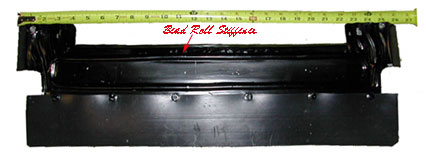"A Tiger Air Dam"
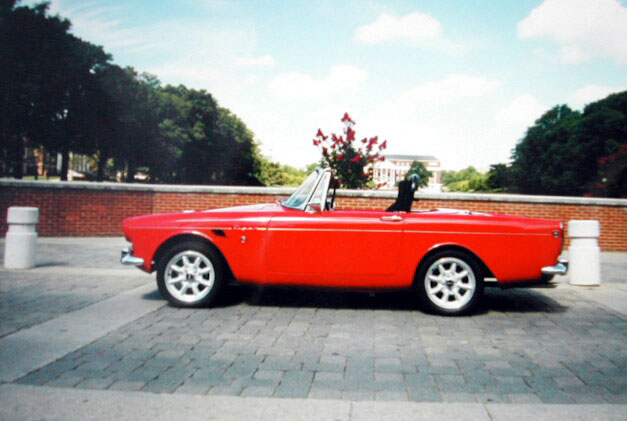
An Article by Larry Paulick
May, 2002
Preface: Larry Paulick explains his new design for a front air dam for the Tiger. This can aid in preventing air recirculation from the hot engine compartment to the radiator input, helping cool the engine, as well as create a low pressure zone under the car front and increasing the downward air force.
Editor
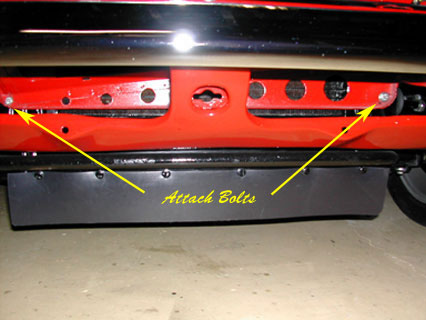
Frontal View of Air Dam
The Tiger has an inherent problem, in the cooling system design. The bottom of the fan shroud does not complete the 360 degree shroud, as the shroud interferes with the rack and pinion. There are also no seals around the other parts of the radiator.
At the bottom, this leads to air going through the radiator, recirculating back under the radiator and feeding this hot air back through the radiator. This is especially pronounced, when the car is at idle, and in stop and go traffic that really taxes a cooling system.
This recirculation of hot air is a major contributor to over heating of the Tiger when at idle or slow speed.
Tiger Tom has an excellent TE/AE Article on cooling, which explains and covers many proven, and tested by Tiger Tom, ways to help keep the Tiger cool.
Steve Laifman has also published detailed cooling design issues, including a lower valance air guide design to prevent recirculation and direct all incoming air through the radiator in the TigersUnited.com "Performance Tuning" "Cool It, Buddy!" Detailed design patterns for making the valance guide and horn hole extender/hole air blockers are provided. This article contains other approaches you may find helpful.
Objective
I looked at the Air Dam to do five things.
1. Stop the recirculation of air coming back through the radiator, when at idle or very slow speeds.
2. Provide a vacuum area under the car, especially the engine bay, so that the air going through the radiator will be drawn through and away from the engine bay, while the car is in motion.
3. I also looked for the air dam to provide a device to help block air going under the car, that tends to lift the car at higher speeds. If this works, as it does on other cars, then the lightness of the Tiger at high speed, due to the car actually lifting, because of the air pressure, would be less.
4. I did not want the air dam to be very visible, but unobtrusive.
5. I wanted a flexible lip, so that if the Tiger hit a curb, or other object, that portion of the air dam would bend and not be damaged. Just like the modern sedans of today, with their plastic air dam lip on the bottom
Design Criteria
The air dam that I designed is very simple, made of metal, and plastic, and just extends down from the front of the radiator, past the cross member, and then about 2” further. This design is very similar to the air dams on ordinary sedan you see on the street today.
The Design
I used very stiff cardboard, and laid out a preliminary design, that was modified after fitting it to the car. This design allowed the air dam to fit to the bottom of the radiator support, and is connected to this frame by 2 small bolts, in 2 new holes drilled in the radiator frame support. The third support of the air dam, is where the metal portion of the air dam rests on the cross member.
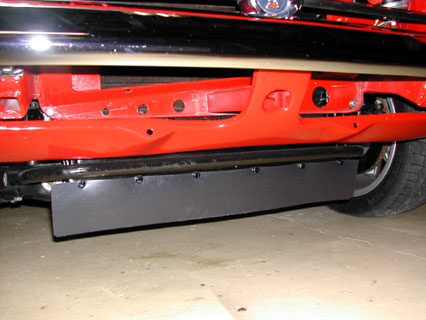
A Different Frontal Angle
It does not rattle, and is snug.
I used a bead roller to add stiffness to the 20-gauge metal of the air dam. You can use thicker metal, if you don't have access to a bead roller, or get your body shop to put the beads into the metal for stiffness.
The design allows for the sway bar, and under the sway bar, the air dam bends towards the rear on each side, to help block the air from recirculating.
On the bottom of the air dam, there is a piece of plastic, which was cut to fit, and bolted to the air dam. This plastic, was cut from stiff lawn edging plastic that is available at any Home Depot, Lowes, etc. You can buy the plastic edging for around $7, and have enough plastic to do 20 cars, or actually use the rest of it around the house and garden.
Yes Dear, I actually bought this for the house. This also takes car of Objectives #4 and #5.
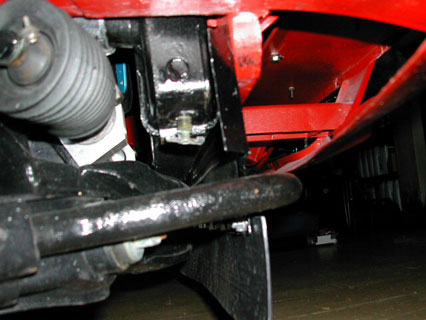
Looking from the Side
Results
Does it work? Well at idle, using a incense stick, which gives off smoke, and a nice smell, the air from the front of the car goes through the radiator. In this test I moved the incense stick, all around the front of the car, including the bottom of the air dam, to watch the flow of the air at idle. Air at or above the air dam goes through the radiator, and air below, goes towards the back of the car. So objective #1 above was met.
I have also been driving the car in 85 degree weather, and the temperature is still in the 170-190 degree range. But I do not have enough time on the car to say that it is a complete test, and Objective #2 has not been fully tested. I suspect that it is.
Does it stop, or reduce lift at high speeds? Objective #5. I will tell you after more testing, but this is such a common fix for this issue, I would be surprised if it did not help this problem as well.
So, its cheap, you can do it, and it will help the idle and slow speed cooling problem due to the lack of recirculation of air back through the radiator.
Larry Paulick
p.s. – You may also notice the holes in the bottom of the radiator support. This support was of an odd trapezoidal opening, and the bottom portion blocked the bottom of the radiator. A hole punch, or saw, will allow more air to get to the bottom of the radiator.
Every little bit helps.
Editor's Note: Yet another solution to the radiator header support bottom obstruction can be found in "Cool It, Buddy!"
 **
**



